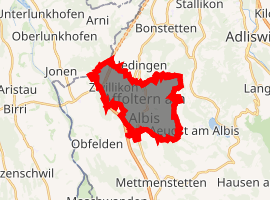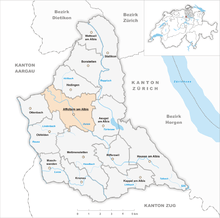Affoltern am Albis
Affoltern am Albis (abbreviated as Affoltern a.A.; Swiss German: Affoltere) is a town and a municipality in the district of Affoltern in the canton of Zürich in Switzerland.
Affoltern am Albis | |
|---|---|
 Coat of arms | |
Location of Affoltern am Albis 
| |
 Affoltern am Albis  Affoltern am Albis | |
| Coordinates: 47°17′N 8°27′E | |
| Country | Switzerland |
| Canton | Zurich |
| District | Affoltern |
| Government | |
| • Executive | Gemeinderat with 7 members |
| • Mayor | Gemeindepräsident Clemens Grötsch unrelated |
| • Parliament | none (Gemeindeversammlung) |
| Area | |
| • Total | 10.56 km2 (4.08 sq mi) |
| Elevation (Central crossing near church) | 491 m (1,611 ft) |
| Population (2018-12-31)[2] | |
| • Total | 12,226 |
| • Density | 1,200/km2 (3,000/sq mi) |
| Postal code | 8910 Affoltern am Albis, 8909 Zwillikon |
| SFOS number | 0002 |
| Localities | Zwillikon, Ferenbach, Loh, Unterdorf, Oberdorf |
| Surrounded by | Aeugst am Albis, Hedingen, Jonen (AG), Mettmenstetten, Obfelden, Ottenbach, Stallikon |
| Website | www SFSO statistics |


The official language of Affoltern is (the Swiss variety of Standard) German, but the main spoken language is the local variant of the Alemannic Swiss German dialect.
History
Affoltern is first mentioned in 1190 as Afiltre.[3]
Geography
Affoltern has an area of 10.6 km2 (4.1 sq mi). Of this area, 45.7% is used for agricultural purposes, while 28.9% is forested. Of the rest of the land, 25% is settled (buildings or roads) and the remainder (0.5%) is non-productive (rivers, glaciers or mountains).[4]
The municipality is located west of the Albis hills in the moraine landscape around the Reuss. It was created in the 19th Century through the merger of Ober- and Unteraffoltern, Zwillikon and Loo-Fehrenbach.
Demographics
Affoltern has a population (as of 31 December 2018) of 12,229.[5] As of 2007, 25.5% of the population was made up of foreign nationals. Over the last 10 years the population has grown at a rate of 9.8%. Most of the population (as of 2000) speaks German (82.5%), with Italian being second most common ( 5.0%) and Serbo-Croatian being third ( 3.7%).
In the 2007 election the most popular party was the SVP which received 37.5% of the vote. The next three most popular parties were the SPS (17.3%), the FDP (11.4%) and the CSP (11.3%).
The age distribution of the population (as of 2000) is children and teenagers (0–19 years old) make up 25.2% of the population, while adults (20–64 years old) make up 62.4% and seniors (over 64 years old) make up 12.3%. In Affoltern about 71% of the population (between age 25-64) have completed either non-mandatory upper secondary education or additional higher education (either university or a Fachhochschule).
Affoltern has an unemployment rate of 2.8%. As of 2005, there were 85 people employed in the primary economic sector and about 33 businesses involved in this sector. 1238 people are employed in the secondary sector and there are 126 businesses in this sector. 3533 people are employed in the tertiary sector, with 441 businesses in this sector.[4] The historical population is given in the following table:[3]
| year | population |
|---|---|
| until about 1700 | 100-250 |
| 1736 | 1,060 |
| 1850 | 1,855 |
| 1900 | 2,779 |
| 1950 | 3,484 |
| 2000 | 10,314 |
Transport
Affoltern am Albis railway station is a stop and a terminal station of the Zürich S-Bahn on the lines S5 and S14 respectively. Its train station is a 28-minute ride from Zürich Hauptbahnhof.
Notable people
- Esther Fischer-Homberger (1940–2019), psychiatrist and medical historian
- Idy Hegnauer (1909 - 2006 in Affoltern) a Swiss nurse and peace activist
- Ernst Nievergelt (1910 in Affoltern – 1999) was a racing cyclist, competed in the 1936 Summer Olympics
- René Strehler (born 1934 in Affoltern) a Swiss former professional racing cyclist
- Giuseppe Reichmuth (born 1944 in Affoltern) a Swiss painter and artist
References
- "Arealstatistik Standard - Gemeinden nach 4 Hauptbereichen". Federal Statistical Office. Retrieved 13 January 2019.
- "Ständige Wohnbevölkerung nach Staatsangehörigkeitskategorie Geschlecht und Gemeinde; Provisorische Jahresergebnisse; 2018". Federal Statistical Office. 9 April 2019. Retrieved 11 April 2019.
- Affoltern in German, French and Italian in the online Historical Dictionary of Switzerland.
- Swiss Federal Statistical Office Archived 2016-01-05 at the Wayback Machine accessed 22-Jul-2009
- Swiss Federal Statistical Office - STAT-TAB, online database – Ständige und nichtständige Wohnbevölkerung nach institutionellen Gliederungen, Geburtsort und Staatsangehörigkeit (in German) accessed 23 September 2019
External links
| Wikimedia Commons has media related to Affoltern am Albis. |
- Official website

- Affoltern am Albis in German, French and Italian in the online Historical Dictionary of Switzerland.